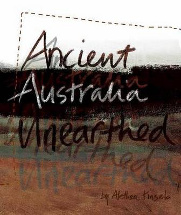Ancient Australia unearthed by Alethea Kinsela

Plainspeak Publishing, 2014. ISBN 9780980594737.
'One October day in 1984, the Department of Aboriginal Affairs in
Canberra was advised by telephone, 'We have a first contact here.'
Located in the Gibson Desert, nine Pintupi people had been picked up
in a four-wheel-drive and taken to Kintore near Alice Springs. They
had never see a non-indigenous person, let alone cars and towns.
Wearing human hair belts and armed with spears and boomerangs the
Pintupi Nine quietly stepped out of the desert and into modern
society. They are believed to be the last people to have lived a
traditional Ancient Australian lifestyle.'
This beautifully illustrated and factually verified book uses
archaeology to track the lives of our indigenous peoples from those
ancient times of 50 000 years ago to modern day society in a
timeline format that makes it a perfect accompaniment to the
Australian Curriculum history strand for Yr 6+. Begun when its
English/History teacher author went to 'spruik the Young
Archaeologists' Program to the Head of Humanities' and continuing to
a blog Ask the
Archaeologist , this book has evolved with the help of
crowd-sourced funding to be a most important resource that fills a
critical gap in both our collections and our knowledge.
Drawing on all the elements of format and layout that attract
today's readers including photographs, maps, information in
manageable chunks, it also actively encourages readers to
investigate, to understand, to inquire and to create with explicit
suggestions. For example, students are asked to consider whether the
early journeys to Australia were accidental or deliberate; to
investigate whether 'firestick farming' is in use today and to
create a description and illustration of a first glimpse of a
kangaroo. There is a broad range of task embracing all levels of
Bloom's taxonomy that can kickstart the teachers' thinking as well
as that of the students. It might even inspire an interest in
archaeology.
Supported by its own website
and a trailer
this book has a place both in the library's general collection and
that of the history faculty.
Barbara Braxton